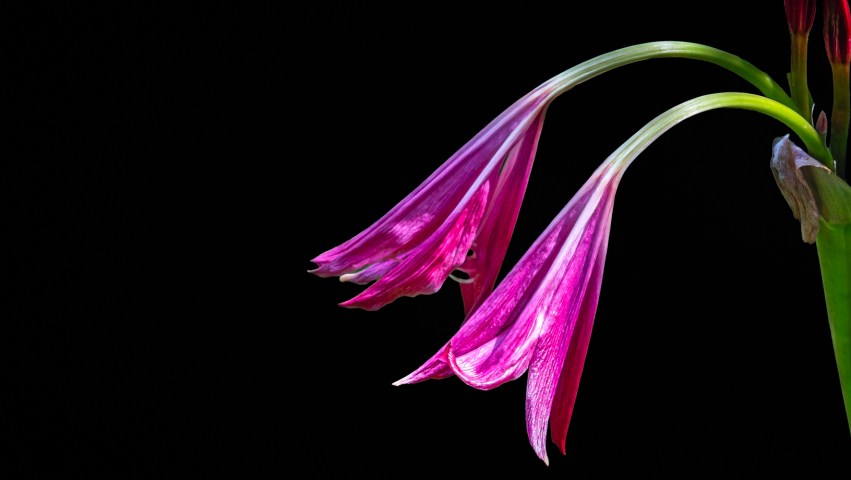From “Summer Blooms” in Through the Garden Gate by Elizabeth Lawrence:
“This summer the black-berry lily, Belamcanda chinensis, bloomed from early June until well into August. There was scarcely a day when there were not several small, ephemeral, red-spotted flowers. They open at various times in the morning, according to the amount of light, I think, but I could never catch them at it, though the clump is right outside my studio window, and I see it every time I look up from my work.
“The flowers close before dark, neatly furling themselves into a minute and almost invisible red and yellow striped barber pole, so they do not detract from the appearance of the plant even though they persist for some time. The handsome pale green seed pods form quickly, and when they burst open, early in September, the bunches of shiny seeds look like ripe blackberries. If the stalks are cut to the ground as they finish blooming, the plant will bloom again in September, but most people like the fruits for winter arrangements. The fan-like foliage is pale green with a delicate silvery bloom, and the stiff, well-branched flower stalks stand well above it. Although the stalks are from three to four feet tall, I am glad I put the plant in the front of the border, for it deserves to be seen as a whole and to stand alone.
”Belamcanda is the Malabar name for the black-berry lily, which grows spontaneously in India where it is considered a cure for snakebite.”
Hello!
It was only last summer that I discovered the charming plant with its pinwheel-shaped flowers featured in this post (and coming up in the next two). It has such a unique appearance — well-described in the quote from Through the Garden Gate above — that I assumed it would be easy to identify, and my friend PlantNet did tell me it was a Leopard Flower whose scientific name was Iris domestica. It’s also commonly known as Leopard Lily or Blackberry Lily, and I explored the history of its name a little in last year’s post (see Leopard Flower Variations). But based on how easy it was for me to find the phrase “blackberry lily” in my botany books and online sources like the Internet Archive — and how infrequently I got hits on “leopard lily” or “leopard flower” — I guess “Blackberry Lily” is its more common-common name. The Blackberry or Leopard Lily is among several other plants often referred to as “leopard lily” — such as those listed on the Wikipedia page Leopard Lily.
I’ve gotten in the habit of referring to it by its scientific name Iris domestica, simply because that keeps me from forgetting that it’s been classified into the Iris family and has never been considered a true lily. But it was only given the name “Iris domestica” in 2005 — see the excellent article Blackberry Lily from the University of Wisconson’s Horticulture site for a history of its names — so in many gardening and botany books you may see references to its original scientific name, Belamcanda chinensis, especially if those books were published before the name change.
Compared to most other irises, Iris domestica is a late — very late — bloomer. I suspect in these photos the plants had been flowering for about a week, since the green seedpods you see in some of the photos have not yet opened to show the blackberry-looking seeds that engendered its “Blackberry Lily” common name. I almost missed them entirely: ’twas a hot and steamy July day when I came across them this year as I was melting my way out of the gardens, but I spent another hour or so taking these shots because they really, really wanted to be photographed.
That I almost missed them this year reminded me of another big miss from earlier in the summer: that I had never gotten a chance to photograph Tiger Lilies because on one of my trips they had not yet bloomed, but by my next trip they were all spent and had blown away. Tiger Lilies seem to bloom almost all at the same time and don’t last long (this is probably not botanically accurate), and we had many multi-day windy thunderstorms right around their blooming time. But the fact that I missed them (and nearly missed Iris domestica) got me thinking that — with several years of photographs taken at Oakland Cemetery’s Gardens — I could probably put together a cheat sheet to remind me which flowers bloomed when.
So I did this: I went through my Lightroom folders for the past five years, and created a spreadsheet of all of the flowers I’ve photographed and the months I photographed them. I ended out with a list of 50 flowers, flower families, and blooming trees, which you can see here (as a pdf) or here (as a picture). Of course the dates reflect blooming times in the U.S. southeast — but I thought others might find the chart a useful reminder of when to be on the lookout for whatever’s blooming next. Among the delights I realized after assembling the spreadsheet: that anemone, angelica, coneflower and asters, goldenrod, and lycoris (a spider lily) will be there waiting for me, in September, October, and November. Wheeeee!
Thanks for reading and taking a look!






































































